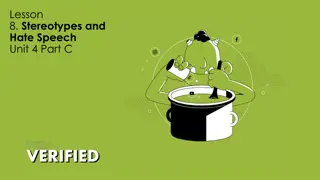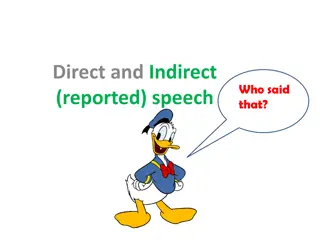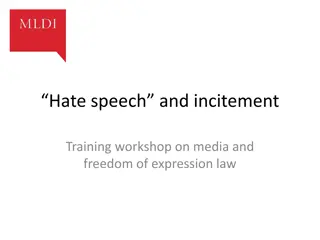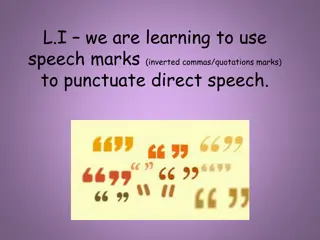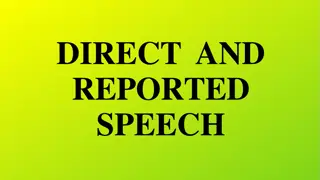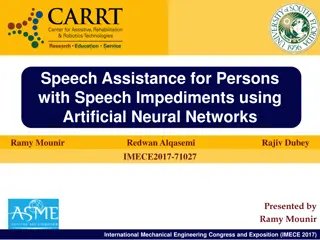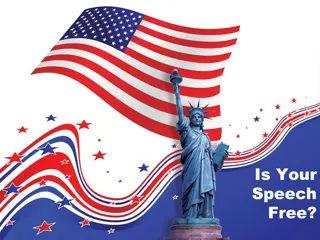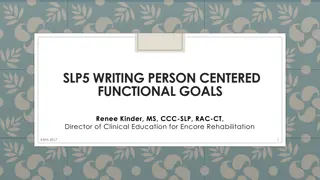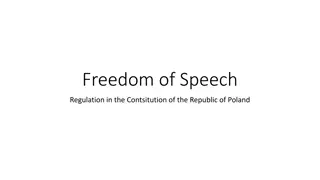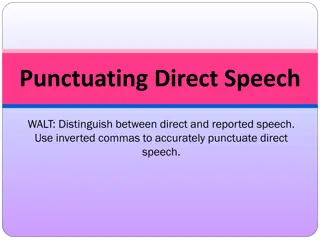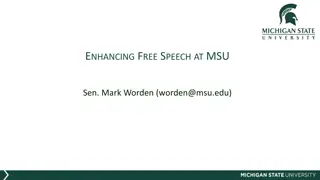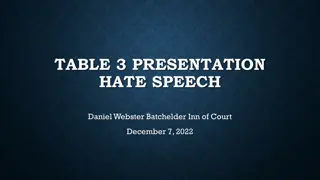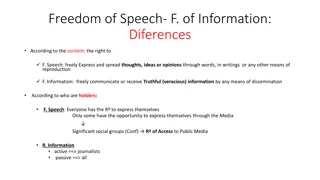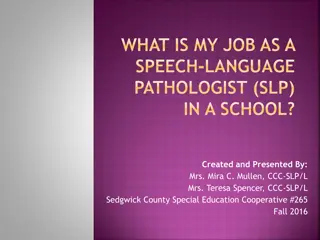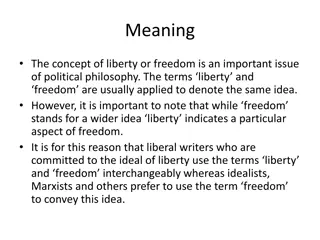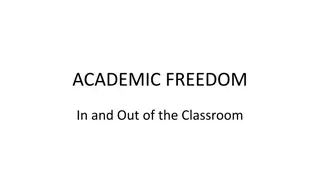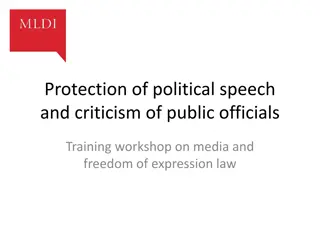Ch3 Freedom of Speech
This content delves into the intricacies of freedom of speech, communication paradigms, and the legal frameworks surrounding these concepts. It explores the First Amendment of the U.S. Constitution, critiques government power restrictions, and analyzes the implications of regulating new communication technologies. Additionally, it discusses the Telecommunication Act of 1996 and outlines free-speech principles upheld by the Supreme Court.
Download Presentation

Please find below an Image/Link to download the presentation.
The content on the website is provided AS IS for your information and personal use only. It may not be sold, licensed, or shared on other websites without obtaining consent from the author.If you encounter any issues during the download, it is possible that the publisher has removed the file from their server.
You are allowed to download the files provided on this website for personal or commercial use, subject to the condition that they are used lawfully. All files are the property of their respective owners.
The content on the website is provided AS IS for your information and personal use only. It may not be sold, licensed, or shared on other websites without obtaining consent from the author.
E N D
Presentation Transcript
Topics Changing Communication Paradigms Controlling Speech Posting, Selling, and Leaking Sensitive Material Anonymity The Global Net: Censorship and Political Freedom Net Neutrality Regulations or the Market?
First Amendment, U.S. Constitution Congress shall make no law respecting an establishment of religion, or prohibiting the free exercise thereof; or abridging the freedom of speech, or of the press; or the right of the people peaceably to assemble, and to petition the Government for a redress of grievances.
First Amendment, U.S. Constitution A restriction on the power of government Criticism of the government and distasteful ideas are generally permitted
Regulating Communications Media New means of publication (e.g., web pages, blogs) No editors or publishers Should First Amendment apply to each new means? Attempts to restrict Freedom of Speech flourish with new technologies each viewed by government as threatening at first, therefore a target of censorship
3-Part Framework for Protection Broadcast (tv,radio) Print media Common carriers (phone, postal svc)
Telecommunication Act of 1996 Major overhaul of telecommunications law Changed regulatory structure, removed artificial legal divisions of service areas and restrictions on telephone companies services No provider or user of interactive computer service shall be treated as a publisher of any information provided by another information content provider Title V of the Act is Communications Decency Act (CDA) outlines regulations concerning obscene materials First major Internet censorship law.
Free-Speech Principles Supreme Court principles and guidelines Laws must not chill expression of legal speech Chilling effect laws are generally unconstitutional Distinguish speech from action. Advocating illegal acts is usually legal Does not protect libel and direct, specific threats Inciting violence, in certain circumstances, is illegal Allow some restrictions on advertising* Protect anonymous speech*
What is Offensive Speech? Political or religious speech Pornography Racial/sexual slurs Abortion or anti-abortion information Depictions of violence Information on how to build bombs Reporting of emergencies and how the government handled them Recording or distributing video acts of violence
Obscenity Supreme Court guidelines (1973) rule that obscenity Depicts a sexual act against state law, Depicts these acts in a patently offensive manner that appeals to prurient interest as judged by a reasonable person using community standards, and Lacks literary, artistic, social, political or scientific value
Obscenity Internet changes practicality of community standard principle want to restrict the country to the standard of the most conservative community?
Communication Decency Act (CDA) Attempted to outlaw indecent communications by focusing on children made it a crime to make available to anyone under 18 any communication that is obscene or indecent Found to be unconstitutional: (1997) Too vague and broad, filtering is less restrictive
Communication Decency Act (CDA) More free speech guidelines Solve speech problems by least restrictive means Do not reduce adults to reading only what fits children Court ruled that the Internet deserves the highest protection from government intrusion
Child Online Protection Act (COPA) Another Internet censorship law It would be a federal crime for commercial web sites to make available to minors harmful material as judged by community standards (1998) Found to be unconstitutional: (2000) Community standard is too restrict Restricts access to lawful content for adults Chilling effect
Children's Internet Protection Act (CIPA) Enacted in 2000 Requires schools and libraries that participate in certain federal programs to install filtering software. Can disable the filter for adults. Upheld in court: (2003) Does not violate First Amendment since it does not require the use of filters, Does not impose jail or fines on people who provide content on the Internet, It sets a condition for receipt of certain federal funds
Video Games & Alternatives to Censorship Violent video games for children Are they more dangerous than other forms that a minor sees in books or other media? In 2011, Supreme Court ruled that violence is common is classic fairy tales, etc. Disgust is not a valid basis for restricting expression. Research found that the impact was small and differed little from the impact of other media Alternatives to censorship Wireless carriers stricter rules on decency Policies that expel subscribers who post illegal, offensive materials, e.g. child pornography Video rating of sex, profanity, and violence
Filtering Software A main alternative to censorship Blocks sites with specific words, phrases or images Parental control for sex and violence Updated frequently but may still screen out too much or too little Not possible to eliminate all errors
Child Pornography and Sexting Pictures or videos of actual minors (children under 18) Laws against creating, possessing, or distributing them Mainly because its production is considered abuse of the actual children, and possessing them encourages production
Child Pornography and Sexting Sexting: sending sexually suggestive or explicit text or photos, usually by cell phone or social media Reduce the penalties for children doing sexting? Child pornography laws need to be revised Also by education, parental involvement, school policies, and reasonable punishments
Spam Unsolicited bulk email, text, tweets, calls, etc Free speech issues Spam imposes a cost on others not protected by free speech Spam filters do not violate free speech (free speech does not require anyone to listen) Anti-spam Laws Controlling the Assault of Non-Solicited Pornography and Marketing Act (CAN-SPAM Act), federal, 2004 Targets commercial spam. Require valid headers, id info. etc. Criticized for not banning all spam, legitimized commercial spam
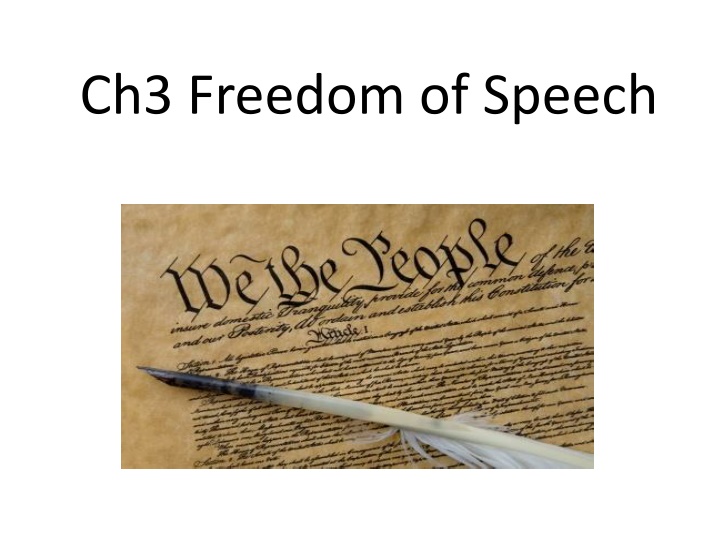

![Prevention and Combating of Hate Crimes and Hate Speech Bill [B.9B.2018]](/thumb/60513/prevention-and-combating-of-hate-crimes-and-hate-speech-bill-b-9b-2018.jpg)



